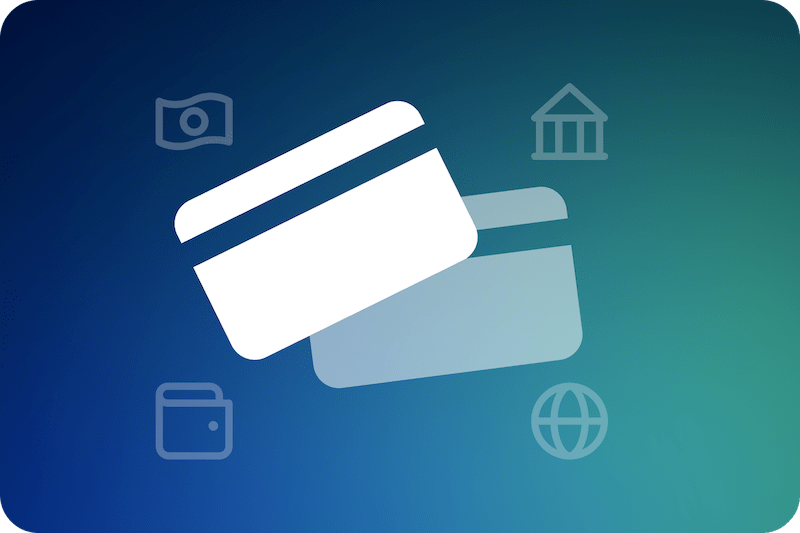How to pay for international business transactions — everything to know
Pros, cons, and when one B2B payment option is better than the others.

As your business expands globally, you might wonder: How should I pay international suppliers or receive money from overseas customers?
Choosing the right international B2B payment method is crucial — it affects your costs, payment speed, and ease of transaction.
Below, we help you navigate the different types of international business payments.
Key takeaways
- International payment options vary, offering flexibility to meet business needs
- Exchange rates can greatly affect the cost of international transactions
- Different payment methods have different advantages, depending on the situation
- Higher costs are associated with international payments due to fees and intermediaries
- Tech advancements are enhancing the efficiency of international payments
How do international business payments work?
International business payments work by transferring money between cross-border bank accounts.
When you make an international transaction, the process behind the scenes can be complicated.
The process typically involves many financial institutions and intermediaries to transfer money:
- Buyer makes a purchase and funds are pulled from their account.
- Funds transfer from the buyers bank to a bank's counterpart in the sellers country.
- The buyer's bank will transfer the funds into the recipient's bank account.
Often an international payment has two or more intermediary banks to complete the transfer.
Due to the intermediaries, international payments are often slower, have more transaction fees, and deal with an exchange rate between currencies.
Types of international payments
When making an international payment, ensure you choose a payment method that best suits your business needs. Here's a list of the types to consider:
International wire transfer
An international wire transfer is a money transfer service that electronically moves money from one bank account to another in a different country.
Wire transfer fees range from $0-$50, and take 1-2 business days to process.When you send an international wire transfer, it first passes through the Automated Clearing House (ACH) network, then through the recipient's country's equivalent network before depositing into the recipient's account.
Pros of wire transfers:
- Fast processing, typically 1-3 business days, though international transfers can take up to 5 days
- Secure and reliable method, widely recognized and used globally
- Direct transfer from one bank to another ensures fewer errors
Cons of wire transfers:
- Can be expensive due to fees ranging from $0–$50
- Requires accurate banking details from both parties, which can be a pain to collect
- Not ideal for very small transactions because of the high fixed costs
EXAMPLE
For these examples, let’s consider GoTrainGo, a hypothetical company that manufactures trains and train cars.
Scenario
GoTrainGo needs to pay a large invoice to a steel supplier in Germany for a bulk shipment of rail-grade steel.
Why a wire transfer is a good option
Wire transfers are ideal for large, time-sensitive payments. They ensure the money is transferred quickly and securely, which is essential for maintaining good supplier relationships and ensuring timely delivery of critical materials.
International payment gateway
International payment gateway facilitates cross-border transactions between customers and businesses. The international transfer occurs through a digital portal, and offers a range of payment methods in multiple currencies.
Pros of the international payment gateway:
- Supports a range of payment methods in multiple currencies, enhancing flexibility
- Facilitates easy, quick, and secure transactions for e-commerce
- Often integrates directly with business platforms for seamless operations
Cons of the international payment gateway:
- May involve transaction fees that vary based on currency and payment volume
- Integration and setup can be complex depending on the business's existing systems
- Can be subject to compliance and security standards that require regular updates
EXAMPLE
Scenario
GoTrainGo sells train car parts to smaller vendors globally through its e-commerce platform.
Why a payment gateway would be a good option
An international payment gateway can handle transactions in multiple currencies and is well-suited for e-commerce. It provides a seamless and secure payment experience for customers around the world, which is crucial for GoTrainGo’s online sales operations.
Letters of credit
A letter of credit — often called an 'LC' — is a commitment by a bank on behalf of a buyer that a payment will be made to a seller by a certain time.
The buyer will establish credit and pay the bank to complete the service. A letter of credit is useful when a seller is satisfied with the creditworthiness of buyer's foreign bank.
Banks will charge a fee, usually amounting to a percentage of the amount sent.
Pros of letters of credit:
- Provides high security for international trade by guaranteeing payment upon fulfillment of agreed conditions
- Reduces the risk of non-payment in international transactions
- Helps establish trust between unknown parties in different countries
Cons of letters of credit:
- More expensive than other methods due to bank fees and administrative costs — from .75% to 1.5%
- Can be complicated to arrange and requires a thorough understanding of banking terms and conditions
- Process can be slow, depending on the banks' efficiency and the accuracy of documentation
EXAMPLE
Scenario
GoTrainGo is entering a contract with a new supplier in Japan for a high-value, custom train engine.
Why a letter of credit is a good option
A letter of credit is a secure way to reduce risks in large transactions, especially with new suppliers. It ensures that GoTrainGo only pays once the supplier meets all contract terms, like proving the train engine has been shipped and delivered as agreed. This method ensures GoTrainGo does not pay until they have evidence that their order has been fulfilled correctly.
ACH (Automated Clearing House)
The ACH electronically facilitates bank-to-bank transfers. To make an international money transfer using ACH, you will need a bank that offers international ACH payments, and you will need to provide transaction details, like the recipient's name, routing, and bank account number.
Pros:
- Lower fees compared to wire transfers, making it cost-effective for regular payments
- Convenient for recurring payments such as payroll or supplier payments
- Generally reliable and secure, overseen by national banking systems
Cons:
- Slower than wire transfers, which can be a disadvantage for urgent payments
- Availability for international transactions might be limited depending on the bank
- Requires accurate banking information, which can be a challenge to obtain internationally
EXAMPLE
Scenario
GoTrainGo pays monthly royalties to a software firm in Canada for using their railway design software.
Why ACH is a good choice
ACH is cost-effective for regular, non-urgent payments. It's cheaper than wire transfers and suitable for routine, fixed-amount transactions like royalty payments. This helps GoTrainGo reduce administrative overhead and ensure timely payments, building a strong business relationship with the software company.
International money orders
International money orders are a paper document used as a method of payment to send funds internationally. You can buy a money order for the amount you wish to send, then mail it to the recipient. The recipient can then do a cash pickup at the bank by exchanging the money order.
Pros of international money orders:
- Simple and secure way to send money abroad without a bank account
- Paid in advance, which eliminates the risk of non-payment
- Trackable, providing proof of payment and receipt
Cons of international money orders:
- Handling and mailing time can delay the funds' availability
- Not suitable for large transactions due to maximum limit restrictions
- Can be lost or stolen in transit, although they are generally replaceable
EXAMPLE
Scenario
GoTrainGo needs to refund a small overpayment to an individual buyer who purchased custom train seat covers through GoTrainGo’s website. The buyer is in a remote area where banking services are limited.
Why money orders are a good choice
International money orders are a reliable option when the recipient may not have access to standard banking services. They provide a straightforward, secure method to send small amounts of money internationally.
Cryptocurrency payments
Cryptocurrency, like Bitcoin, is an alternative to traditional currency by using a digital currency. With crypto, you don't have to worry about currency exchanges. You can also avoid slow processing times and costs of traditional international money transfers.
That being said, crypto can be riskier, as it doesn't come with legal protections, and the value of these digital coins fluctuate and can be extremely volatile.
Pros of cryptocurrency B2B payments:
- Fast transaction times with reduced need for intermediaries
- Lower transaction fees compared to traditional banking systems
- Not tied to any particular currency's exchange rate, potentially saving on conversion fees
Cons of cryptocurrency B2B payments:
- Highly volatile; the value of crypto can significantly fluctuate
- Lacks the legal and regulatory protections typical of traditional currencies
- Still not widely accepted as a payment method by all businesses
EXAMPLE
Scenario
GoTrainGo decides to purchase bespoke software from a tech startup based in a country with restrictive currency regulations.
Why cryptocurrency is a good choice
Crypto offers a fast, borderless transaction method free from traditional banking restrictions. It's ideal for GoTrainGo in this scenario to circumvent cumbersome regulations and potentially save on transaction fees.
Credit card
Credit cards can be used for international payments, but may have fees ranging from 1-3% of a purchase.
Pros of credit card payments:
- Widely accepted and easy to use for international transactions
- Offers consumer protections such as chargebacks and fraud protection
- Can extend cash flow by allowing for later payment
Cons of credit card payments:
- Fees can be high, especially with international transactions and currency conversion
- Not the most cost-effective method for large transactions due to percentage-based fees
- Potential for fraud and security issues, which require robust protection measures
EXAMPLE
Scenario
GoTrainGo employees travel internationally to various trade shows and need to cover their travel expenses.
Why credit cards are a good choice
Credit cards are widely accepted and offer convenience and security for international travel-related expenses. They also provide benefits such as fraud protection, easy tracking of expenses, and the possibility of earning rewards.
Bank drafts and checks
Bank drafts and checks are traditional forms of payment where funds are written and drawn directly from bank accounts. They are commonly used for both domestic and international transactions when digital payments are not an option or preferred for security reasons.
Pros of bank drafts and checks:
- Widely accepted by businesses and individuals in most countries around the world
- Secure and provide a traceable and verifiable method of payment
- Since they can take some time to clear, the sender does not need to have the full amount in their account at the time of issuance
Cons of bank drafts and checks:
- Slow processing times can take several days or even weeks to clear, especially for international transactions
- May incur substantial bank fees for both sender and receiver
- Physical checks can be lost in the mail or stolen, which might lead to financial fraud
EXAMPLE
Scenario
GoTrainGo has to reimburse a supplier in a country where electronic payments are not the norm, and traditional banking is more reliable.
Why bank drafts and checks are a good choice
Even though they're slow, bank drafts and checks are ideal for GoTrainGo in this case because they are widely accepted and comply with local banking regulations. They provide a clear, documented proof of payment, which helps with accounting and taxes. They also avoid issues related to the lack of digital payment infrastructure.
EFT payments
Electronic Funds Transfer (EFT) is a broad term that covers various types of digital payments. EFT allows money to be transferred electronically from one bank account to another, which can include direct deposits, wire transfers, direct debits, and electronic checks.
EFT is a broad term encompassing all forms of electronic payments, including ACH, which specifically refers to a network for processing bulk, batched electronic transactions primarily within the U.S.
Pros of EFT payments:
- EFTs process quickly, often within the same day, which is ideal for timely payments
- Generally incur lower fees than traditional bank transfers or checks
- Enhanced security measures reduce the risk of fraud compared to physical payment methods
Cons of EFT payments:
- Requires both sender and receiver to have bank accounts, which may not be available in all regions
- While usually fast, EFTs can sometimes be delayed due to bank processing times, especially on weekends and holidays
- Initial setup of EFT arrangements can be complex, requiring detailed information and verification.
EXAMPLE
Scenario
GoTrainGo needs to regularly make payments to their component manufacturers in various European hubs, including urban centers in Slovakia and Spain, to keep their production lines running smoothly.
Why EFT payments are a good choice
EFT stands out as the best payment method for GoTrainGo because it enables seamless and rapid money transfers across diverse banking infrastructures throughout Europe. This efficiency ensures that all suppliers, regardless of their location, receive their funds promptly, which is essential for keeping the supply chain intact. Further, the digital nature of EFT reduces administrative overhead and improves security.
SEPA transfers also be a good option here.
SEPA transfers
SEPA, the Single Euro Payments Area, streamlines bank transfers across Eurozone countries by letting businesses make cashless euro payments under the same conditions, and obligations, regardless of their location.
Pros of SEPA transfers:
- Generally offers lower transaction fees compared to other international transfer methods.
- Faster processing times, typically completing transfers within 1–2 business days
- Standardizes euro payments across Europe, making transactions straightforward and predictable
Cons of SEPA transfers:
- Only works with euro transactions within the Eurozone countries.
- Requires both sender's and receiver's banks to be part of the SEPA zone
- Restricted to euro. SEPA doesn't support other currencies that might be needed for business outside the Eurozone
EXAMPLE
Scenario
GoTrainGo needs to make regular monthly payments to suppliers located within the Eurozone.
Why SEPA transfers are a good choice
SEPA transfers are ideal for GoTrainGo because they offer a reliable and cost-effective way to handle transactions within the Eurozone, ensuring payments are processed quickly and uniformly without currency exchange fees.
SWIFT transfers
SWIFT transfers are secure and reliable, allowing banks to send money globally through a widespread network. They are not limited to any specific country or currency, making them ideal for international transactions.
Pros of SWIFT transfers:
- Enables money transfers to almost any country and in any currency
- SWIFT is secure secure, utilizing encryption and authentication protocols
- Widely trusted by banks and financial institutions worldwide for international transfers
Cons of SWIFT transfers:
- Typically involves higher fees than domestic transfers or SEPA for Eurozone payments
- Can take several days depending on the banks and countries involved
- Often requires more detailed information about the recipient’s bank and account details
EXAMPLE
Scenario
GoTrainGo is collaborating with a subcontractor in Brazil to source custom-designed train brakes for their new high-speed train. The subcontractor, located in an industrial hub outside São Paulo, requires payment in Brazilian real and does not have access to European payment systems like SEPA.
Why SWIFT transfers are a good choice
SWIFT transfers are ideal for GoTrainGo in this situation because they offer a reliable way to handle international payments directly in Brazilian real. Accepting international payments with SWIFT lets GoTrainGo manage payments from their headquarters in Europe to Brazil efficiently. SWIFT’s network ensures that the transaction is traceable and secure, providing both parties with peace of mind.
How international payments are different from domestic payments
Sending money internationally is different from domestic payments due to: different currencies, regulations, processing time, intermediaries, risk, and cost.
Currencies
Domestic transactions involve only one currency, whereas international payments involve a currency exchange.
Regulations
Domestic payments only fall under one country's regulation, but international payments have to take into account the rules and regulations of the payee's and the payer's country.
Processing time
Domestic faster payments are oftentimes faster than sending international payments.
Intermediaries
When you send an international payment, there are often more intermediaries to facilitate the payment.
Risk
International payments are riskier than domestic payments. Not only is there a foreign exchange rate risk as currencies fluctuate, but there's also geopolitical risks, sanctions, and different regulations to be aware of.
Cost
Domestic payments are usually cheaper to send than international money transfers due to conversion fees, and payment gateway/banking fees.
What international business payments are used for
International business payments can be used for:
- Purchasing goods and services
- Employee wages
- Dividends and interest
- Investing in forgiven businesses/real estate
- Obtaining assets
- Traveling
- Charitable donations
- Financial market transactions
- Sending money overseas
How do exchange rates affect international payments?
Exchange rates play a critical role in international payments, impacting both the cost and the amount of money that finally reaches the recipient. Here’s how exchange rates affect these transactions:
- Cost fluctuations: Exchange rates affect how much money you send or receive in international payments. If the rate is unfavorable, you could end up paying more or receiving less.
- Timing: Since exchange rates change due to economic and political factors, the timing of your transaction can affect how much value you get. Some businesses use financial tools like forward contracts to lock in rates and reduce this uncertainty.
- Extra fees: Converting one currency to another isn't free. Banks charge fees for this service, which can increase the overall cost of international payments, especially for large transactions.
- Financial risk: Regular international transactions expose businesses to the risk of losing money if exchange rates shift unfavorably. Many businesses manage this risk by using strategies to protect against big swings in rates.
- Invoicing choices: Businesses sometimes invoice in their home currency to avoid exchange rate issues, but this can shift the burden to the customer, affecting sales and market competition.
Challenges and solutions in international payments
Handling currency exchange rate fluctuations
- Use currency hedging by creating a contract that specifies selling an amount of currency at a future date, but at today's exchange rate.
- Increase the export selling price to offset fluctuations.
- Take advantage of financial instruments, bankers, and foreign exchange brokers.
Managing transaction fees and hidden costs
- Use a payment provider that is transparent on costs.
- Pay vendors in local currency.
- Choose digital payment methods.
- Consider foreign exchange hedging.
Overcoming regulatory and compliance hurdles
- Build relationships with local banks, who will be more knowledgable on regional regulations.
- Seek local expertise to understand the specifics regulations you need to adhere to.
- Implement robust internal controls and ensure software security is up-to-date.
- Complete regular audits to identify weaknesses in your payment systems.
Ensuring security in cross-border transactions
- Choose a payment provider that encrypts data and has a good reputation.
- Monitor transactions and watch for signs of fraud.
- The impact of technology on international payments
Advancements in technology and fintech are making it easier, cheaper, and safer for businesses to send money internationally. Fintech innovations are tackling the challenges of cross-border payments by improving exchange rate management and the payment experience overall.
Blockchain technology and cryptocurrencies simplify international payments by cutting out many intermediaries, lowering costs and speeding up transaction times. Cryptocurrencies like Bitcoin enable quicker and cheaper cross-border payments.
Similarly, modern payment gateways streamline transfers by supporting various payment methods in multiple currencies. This flexibility lets businesses sell products globally and enhances international trade.
Leading international payment providers
Payment providers enable you to accept electronic payments securely. When choosing a payment provider for your business consider the cost, security, payment methods, and integration with your current softwares.
Plooto
- All-in-one platform: Provides a comprehensive payment automation platform that simplifies all aspects of business payments, from accounts payable to accounts receivable
- No foreign exchange fees: Offers plans that eliminate foreign exchange fees on transactions, providing significant savings
- Speed: Facilitates faster payments through Plooto Instant, enhancing cash flow efficiency
- Compliance: Meets or exceeds rigorous regulatory compliance standards applicable to Fortune 500 companies, ensuring trust and security
- Global reach: Supports transactions in over 40 countries and 25+ currencies, making it ideal for businesses operating internationally
Worldpay
- Availability: Worldpay services available in 40+ countries and accepts 120 different currencies
- Contract terms: Often requires lengthy contracts and may include early termination fees, which can be a drawback for some businesses
- Transparency: Pricing can be unclear and variable, which might complicate budget planning for businesses
Opayo
- Service options: Opayo offers service tiers to cater to different businesses
- Pricing clarity: Lacks transparency in pricing, which can be a concern for businesses trying to manage expenses
Stripe
- Integration: Stripe is known for good API and easy integration with numerous platforms
- Currency Support: Accepts payments in 135+ currencies across 46 countries
- Compliance: Maintains standards of regulatory compliance
Paypal
- Availability: PayPal operates in over 200 countries and supports 25 different currencies.
- Ease of use: Known for its user-friendly interface and quick setup.
- Fees: Transaction fees vary, typically around 3% for currency conversions, plus international payment fees.
- Security: Well-regarded for consumer protection but has experienced issues with account freezes.
TD bank
- Fees: TD Bank charges for transfers, conversions, and potentially third-party fees
- Service availability: Offers online services and supports a variety of payment options
- Geographical reach: Capable of transferring money between a wide range of countries
Ayden
- Currency Support: Ayden supports over 30 currencies
- Fees: Charges a fixed processing fee and a variable fee depending on the payment method
- Security: Good security standards
FAQs
Don't see your question answered here? Contact us today.
How long do international business payments take?
International business payments can take anywhere from one to five business days depending on destination country, the payment method, and degree of verification checks during the transaction.
How much does an international business money transfer cost?
The cost of an international payment varies based on the transfer method and the provider you use. For example, with online banking, you can send money for $0-$25, and wire fees can cost $0-$50.
Related reading
Table of contents
How payments work Types of payments
Sign up in minutes.
Start saving hours.
Manage all of your payments in one platform. No jumping between apps necessary.
Start free trialReady to streamline your international payments?
Sign up for a free trial of Plooto today and experience the ease of managing global transactions with no hidden fees, fast processing, and top-notch security.
Start free trial

